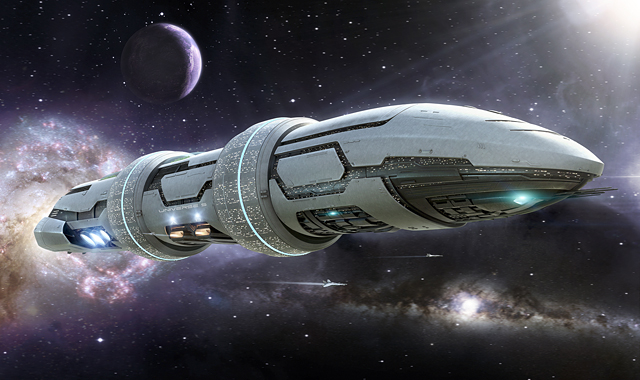 UGC Clariont Flag. |  UGC Clariont Flag. | ||||
|---|---|---|---|---|---|
Name: DAVID ESTEP-Class Model Type: Hospital Ship Crew: Passengers: Up to 10,000 sick and injured persons, plus up to 200,000 uninjured persons; 200 infants; ships crew, etc. MDC By Location: | |||||
| * Hull- Forward Section (1/4) Midsection (1/4) *** Main Thrusters (4, comprising the stern 1/4 of the hull). ** Bridge- Side Pods (2) Lower Pod *** Secondary Thrusters (9, stern of side and lower pods) | 105,000 33,000 30,000 10,000 each (40,000 total) 4,500 20,000 each 12,000 2,500 each | **** Pinpoint Barrier Force Field (6)- **** Variable Full-Force Barrier Force Field- External Hatches (about 1,000)- Internal Hatches (up to 100,000)- Solar Panels (up to 20)- Sensory Arrays (up to 05)- 500 each Medivac Shuttle Launch Bays (10) Hanger Doors (20) | 10,000 each 100,000 total 150 each 100 each 100 SDC each (not MDC) 500 each 2,000 each 5,000 each | ||
* Depleting the MDC of the main hull will utterly destroy the ship, leaving it a drifting wreck, on fire, hard vacuumed, and/or blowing up entirely. ** Destroying the command tower will instantly kill the command staff and deprive the ship of all forms of long range communications, radar and targeting. The range and targeting capabilities of the secondary systems are equal to that of an Alpha. The ship can still operate, but is at -3 on initiative, -3 to strike, and number of attacks per melee of the weapon systems are reduced by half. *** Depleting the MDC of the rear sections means that the ship's engines and thrusters have been destroyed, half of the main Mecha hangers, and all personnel, Mecha & equipment in those sections when it was destroyed. The ship will be adrift in space without any means of propulsion, and on auxiliary life support. However, the command towers, forward Mecha hangers, missile launchers, weapon systems and pinpoint barrier are still fully operational. Also, the Tractioning Drive will be unaffected, as will solar sails; A master Spacer MIGHT be able to rig the vsl to run away form the battle between these **** Depleting the MDC of the main engines will force the ship to rely on its secondary engines. Depleting the MDC of the main engines AND secondary engines will leave the ship adrift in space. If in an atmosphere, the ship will crash (destruction of the main engines will render the antigravity system useless due to loss of power). The Pinpoint and Variable Full-Force Barrier Field regenerate at a rate of 1,250 MD per second (2,500 MD per melee action). If destroyed, a barrier will completely regenerate within four seconds (2 melee actions). See the Pinpoint Barrier Field and Variable Full-Force Barrier Field for more information on these systems. | |||||
| Spacefold: Mk3 Epsilon variant spacefold. FTL: Factor 2 Cruising Speed: Mach 10 In Atmosphere: Clearance: 1,489 feet, 6 inches Beam: 1,388 feet Length: 4,961 feet Weight: 162 million tons. Cargo: 500 million tons. | Power Systems: Cost and Availability: 10 million credits, plus agripods (500,000 credits each); Always available. Black Market: Billions; Ultra-rare. | ||||
| 1. Pin Pinpoint Barrier Defense System: Originally developed by researchers onboard the SDF-1 during the First Robotech War, the Pinpoint Barrier System is a standard defense system on board all large REF starships, including the IZUMO-Class Battleships (which the ESTEP-Class was converted from). The system generates four disc-shaped force fields 5002 in area that can be positioned anywhere along the ship to deflect missiles, energy beams or projectiles. Each pinpoint barrier can absorb up to 10,000 MD in damage, which then regenerates within four seconds (2 melee rounds). The barriers can also be layered on top of each other to generate a field which provides 20,000 MDC and can even deflect Reflex Cannon beams (usually). The six barriers are controlled by operators in the command tower of the Hospital Ship, who are trained to defend (1) main engines, (2) the command tower/bridge, (3) sensor array/hangar bays, and (4) other systems, in that order. The operators primarily concentrate on defending the ship against larger spacecraft and missiles, leaving Mecha defense to the Mecha. Purpose: Defense (the system can NOT be used as a weapon) MDC: Can sustain up to 5,000 MD per round. Regenerates at a rate of 2,500 MD per melee round. Range: Up to 300 feet (91.5 m) from the surface of the vessel. Radius: 500 ft (61 m) Attacks Per Melee: Can move from one end of the ship to the other in less than a single round. Trained operators can attempt to block attacks up to 8 times per melee (counts as a parry) and are at +7 to block. Untrained characters can parry up to their number of hand-to-hand attacks with their normal parry bonuses only. PAYLOAD: Nearly inexhaustible. Will work as long as system is functional (see below) and engines are intact. If main engines are destroyed, the barrier will loose power and not function. NOTE: If all four barriers are grouped in a single spot they can deflect a heavy particle beam attack, such as the one generated by the SDF-1, T'sentrædi command warships, and Tiresian ships. However, the beam will completely destroy all four barriers and put incredible strain on the pinpoint barrier system, to the point where it may short out. After deflecting an energy beam, roll percentile dice on the table below to determine additional effects/damage.01-15: Lucked out, system will be operational in 1D6 hours. 16-30: Minor damage, system will require 4D6 hours to repair. 31-45: Major damage, system will require 2D6 times 10 hours to repair (yes, DAYS of work). 46-60: Completely destroyed! System can be rebuilt, but will require new parts and 2D6 DAYS of work to replace. 61-75: Major damage, system will require 2D6 times 10 hours to repair. 76-90: Minor damage, system will require 4D6 hours to repair. 91-95: Lucked out, system will be operational in 1D6 hours. 96-00: It's a miracle! Trivial damage only, system will be operational again in only 4D6 melee rounds! 2. Defensive Laser Batteries (200): A battery of defensive lasers dot the hulls of these vessels. Mostly for anti-missile and meteorite defense. 3. Ships, Shuttles, Power Armor, and Robots: | 4. DS-25 Variable Full-Force Barrier Defense Field: The DS-25 VFFBDF is a hybrid of the DS-1 Pinpoint and DS-2 Full-Force Barrier Defense Fields; Essentially, 06 DS-1 generators form shields about 200 feet away from the ship, each overlapping 1/4 area of the 4 it borders, creating a 50% overlap area; Essentially a 50/50 chance of hitting TWICE the MDC. However, each individual shield's MDC can be adjusted, potentially negating this advantage. The shields are fully adjustable, but each shield MUST HAVE an MDC point or the entire system will collapse; The can not be any uncovered area. The shields regenerate in four melees to full-strength, and can even deflect Reflex Cannon beams (barely). The unusual configuration of the shield energizer allows the ship to fire ENERGY WEAPONS through the shield; However, this version is wickedly expensive, and therefore it's installation on warships is awaiting a full cost/benefit analysis. The DS-25's design is heavily influenced by the T'sentrædi Gnerl Fighter Pod's variable Force Field; It was NOT used on the IZUMO-Class Battleships. MDC: Can sustain up to 5,000 MD per round. Regenerates at a rate of 2,500 MD per melee round. Range: Up to 300 feet (91.5 m) from the surface of the vsl. Radius: 500 ft (61 m) Attacks Per Melee: Can move from one end of the ship to the other in less than a single round. Trained operators can attempt to block attacks up to 8 times per melee (counts as a parry) and are at +7 to block. Untrained characters can parry up to their number of hand-to-hand attacks with their normal parry bonuses only. PAYLOAD: Nearly inexhaustible. Will work as long as system is functional (see below) and engines are intact. If main engines are destroyed, the barrier will loose power and not function. NOTE: If all four barriers are grouped in a single spot they can deflect a heavy particle beam attack, such as the one generated by the SDF-1, T'sentrædi command warships, and Tiresian ships. However, the beam will completely destroy all four barriers and put incredible strain on the pinpoint barrier system, to the point where it may short out. After deflecting an energy beam, roll percentile dice on the table below to determine additional effects/damage. NOTE: TOP SECRET INFORMATION: Each ESTEP-Class Hospital Ship actually carries 6 DS-25 generators, each on a semi-independent power system; Secure power to a damaged system BEFORE energizing a new system. This will cause a temporary dip in the shield; Every enemy that has tested the system has mistaken this for the system compensating for the shield's power supply recovering from an attack. | ||||
Range is about 200 miles for MOST sensors. | |||||
| |||||
